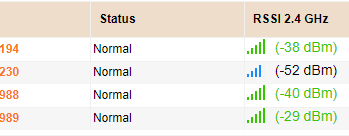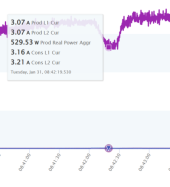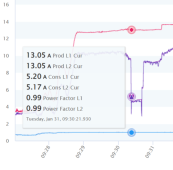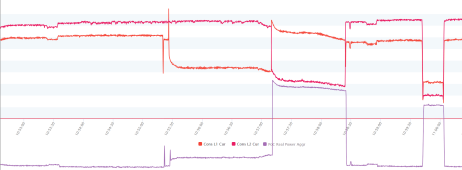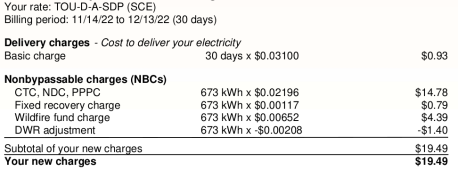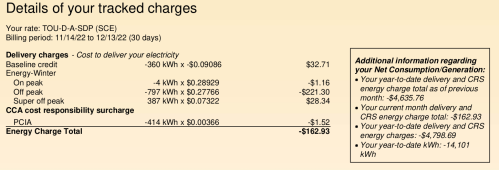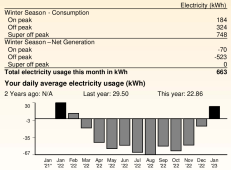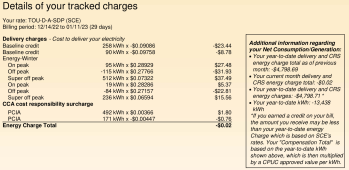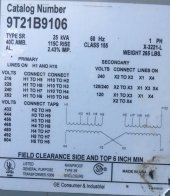The 24 cents per kilowatt hour (they raised it 1 cent, it's now 25) is their estimate after adding in all of the fees and taxes. I have to give So Cal Edison a little credit here. They may be a total rip off, but they are at least honest about it. The one part that throws a wrench into calculating it is the minimum monthly charge. When you use so little power, it makes it look very bad.
Last billing period that ended Dec 17th I did net consume 61 KWHs for the whole month. They charged me a total of $19.36 for using that amount of energy. That was after all the NBCs, taxes, etc. That means I had to pay $0.3173 per KWH. That is average for the entire day, not breaking down the different time of use rates. Since most of my consumption is at the lower rate, the difference is likely the added NBC charges.
The bill before that looks completely wrong. For the whole month, I used a net of -80 KWHs. That's right, I gave them more energy than I used. For that bill, they gave me a credit of $6.70 after you tack on the NBCs and taxes. So for this export month, they only paid me $0.08375 per KWH. The bulk of that difference seems to come down to the minimum charge of $9.85 and the $0.022 NBC. I kept the flow very low with the battery, but that still came to 109 KWH they charged on the NBCs. $2.40 is a small number, but when it is on such a small balance, it becomes a fair percentage. I am still not completely sure where they came up with 109 KWH for these charges, that does not work out to the amount of energy in+out. Adding the in and out together is still only 89 KWHs. So it must be something to do with the energy that went into my home, even if I later exported energy.
Here are the rates quoted by SCE.
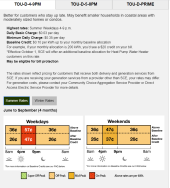

And here is what they charged me just for the energy on the actual bill.
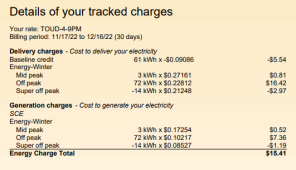
We are in winter, so the rates quoted are Mid Peak $0.41, Off Peak $0.28, and Super Off Peak $0.25
Looking at the actual bill, Mid peak rate is $0.27161 for delivery and $0.17254 for the energy. Added together it is $0.44415 but then I save $0.09086 on the baseline credit, bringing it down to $0.35329 before taxes and NBCs. And the quoted rate is up at $0.41 to cover off those extra costs.
The other rates are lower on both the generation and delivery. And the numbers they are still using on my NEM 2.0 plan is just the total for the whole month. If I consume 400 KWH and then Export 400 KWH in any given rate, the total here should be zero, but not on the NBC's.
Here is the NBC's for the same month bill
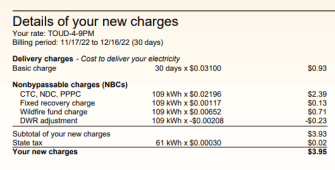
It all totals just over $0.03 per KWH, but where is the 109 KWHs coming from? Since I did consume power on this month, there was no added minimum charge.
They certainly do play a bit of a numbers game to make it more confusing. Even though I am on a monthly billing plan, they still total up the energy separately on my bill and give two separate running totals. I know they do this for the yearly billing since they charge all the taxes each month, but then bill the energy at the end of the year. If I owe for energy, I pay it each month on this plan. But when I have a credit, they keep adding it up until the end of the year still. I currently have an energy credit of $14.61 and thanks to the energy rebate, I still have a $33.16 credit to keep covering taxes and NBCs. With this lousy weather we are having, I am going to likely burn up all of those credits at the end of my Jan. billing cycle.
Do I need to start writing down the numbers off my power meter again to track what they are seeing? I know it has a separate running total for the energy into my house and the energy export from my house. No count ever actually goes backwards.




